GMS Field Trip
If you have any questions about field trips send email toGMS Field Trip
Quarry/Plant Tour and Marble in Tennessee
Friday, April 20, 2018
The second April field trip was a very small group tour of a quarry and processing plant in Tennessee. The company is a family owned business and our tour guide for that day is the current owner. We started the tour with the geology of the area plus a history of the company and other quarries in Tennessee.
The owner explained the belt they mine in Tennessee spans approximately 200 miles and is part of the Holston formation. Based on fossils found in the stone, mostly Ordovician crinoids, bryozoans, brachiopods, and cephalopods, the material is approximately 450 to 485 million years old. Colors vary from a delicate light pink rose to a dark rose to a color they call cedar, a mottled pink/brown color, and another soft gray color. Though it is called marble, the material is geologically a very fine limestone, but it is so fine and takes such a beautiful polish, it is considered a type of marble in this industry. We also observed a great deal of jagged black lines in the stone called stylolites, i.e. areas that have been dissolved under pressure and replaced by other minerals.
From the mid to late 1800’s through the 1930’s, the band was a very active mining area. Tennessee marble was in great demand for many high profile buildings and as a sculptural medium. It can be seen in Grand Central Station as well as numerous monuments, libraries, and museums in Washington D.C., Knoxville, TN, and in other states. Most people are unaware that Patience and Fortitude, the lions that grace the steps of the New York Public Library, were sculpted from Tennessee marble. Yet, over time, as tastes began to change and turn to other materials, demand declined, so by the 1950’s, there were only a handful of active quarries. By the 1980’s, the industry was essentially gone. But thanks to the company we visited, Tennessee marble has seen a renaissance. In the 1990’s they revived the industry, albeit on a smaller scale, and cleverly found a new niche for the material. Unlike other quarries we have visited, this quarry is not being mined for quantity; it is being mined for quality. The company is highly respected in the industry for its ability to match material in old buildings and for being able to incorporate new material seamlessly. They have received many accolades and continue to excel in restoration efforts.
The plant is impressive. It houses state of the art equipment while still employing highly skilled master carvers. There is a machine that processes a large slab from 80 grit to 800 grit, then an acid polish, all in one pass! That machine also has a “bush hammer” that contains little spikes that can put dimples on the surface of a slab to make it safer for foot traffic. The machine is programmable and includes integrated sand blasting as well. The CNC machine (computer numerical control) is another programmable process that can cut intricate designs out of stone and into stone. The CNC operator showed us some of the specialized bits that are used in the process. Outside the plant there are two large saws that use different technologies. One has a reciprocating saw blade and the other uses a plastic line embedded with segments that contain diamond. Both saws cut one slab at a time. Nearby, there is a “gang saw” that cuts multiple slabs at a time with 60 blades. Everyone was surprised by how clean the plant is. Their processes are designed to be safe for the environment and great care is taken to reuse, recycle, and manage the resources available.
The quarry is not large by most quarry standards. The formation at this site contains a lot of fractures and mud seams, so quarrying can be tricky. Small amounts of material are removed carefully to preserve as much of the material as possible – no blasting here. The history of the quarry is visible on the walls where you can see drill marks from old techniques juxtaposed with smooth walls from new techniques. Old quarrying methods involved drilling holes close together along each face of the block to liberate what would now be considered a small block of material, about 5 feet by 6 feet by 4 feet. Now, they use a plastic line embedded with diamond similar to the saw that was cutting a big block outside the plant. This method cuts blocks that are at least double the size of the old blocks with considerably less effort, less damage, and less loss of material. In addition, they have a 12 foot chain saw that can make horizontal and vertical cuts. That’s right, a 12 foot chain saw!
The trip concluded with permission to pick up as many scraps of material as we wanted. We found a pile of little marble “sticks” for grab bags as well as pieces with crinoid fossils plus several different colors of beautiful stone. After everyone collected as much as their vehicles could carry, we reluctantly bid this wonderful place “adieu”.
We cannot thank the owner enough, not only for allowing us to visit her company, but also for her personal tour. Thank you to Charles for setting up this trip. It took a lot of time and his efforts are greatly appreciated.
Lori Carter
On behalf of Charles Carter, GMS Field Trip Chair
e-mail:
Photos by Lori Carter

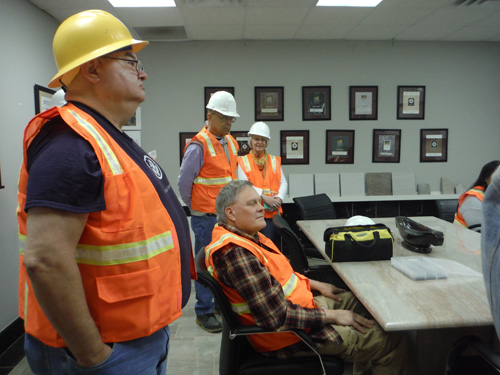

The tour started with an explanation of the geology plus a history of the company
Photos by Lori Carter

Core samples illustrate the colors in the quarry: light rose, dark rose, cedar, and gray
Photos by Lori Carter





Tile samples along the wall show the fossils that can be seen in some of the material
Photos by Lori carter


On the plant tour we saw a machine that takes a raw slab from 80 to 800 grit plus an acid polish in one one pass!
Photo by Lori carter

The bush hammer
Photo by Lori carter

A polishing wheel
Photo by Lori carter

A head from the polishing wheel
Photos by Lori carter
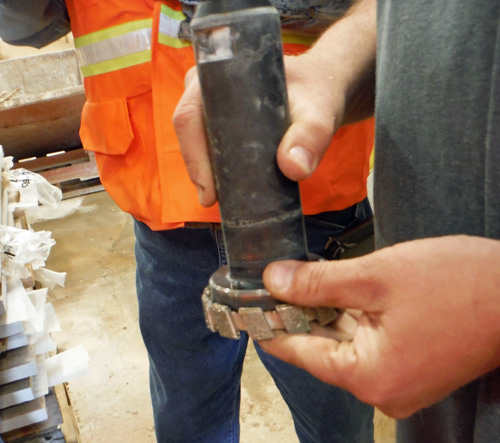


Specialized bits for the CNC machine
Photo by Lori Carter

Raw slabs waiting to be processed
Photo by Lori Carter

A master carver hand carved this beautiful block
Photos by Lori Carter




These curved pieces are for a restoration project.
Note the last picture where grooves like those in the prior picture have been sand-blasted smooth.
Photos by Lori Carter
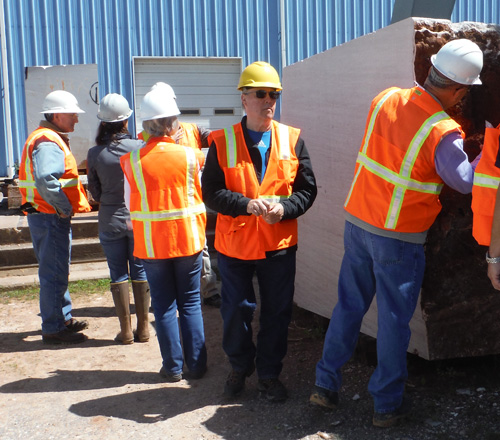
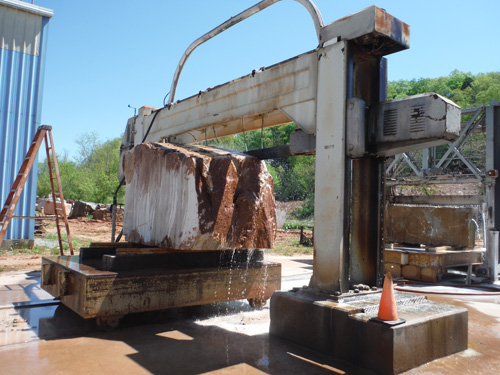



Outside we saw a reciprocating saw and line saw in action
Photos by Lori Carter




The gang saw with examples of slabs cut with the saw and some blades waiting to be refurbished
Photos by Lori Carter


A view of the quarry and some recently cut blocks
Photos by Lori Carter


Older part of the quarry. Note Daniel Miller in the second picture with the 12 foot chainsaw in the background.
Photos by Lori Carter


Carl Davis is examining old drill marks
Photos by Lori Carter


Charles is standing where you can see old drill marks next to new cuts
Photos by Lori Carter


We were allowed to explore part of the quarry and Rose found some brachiopod fossils!
Photo by Lori Carter
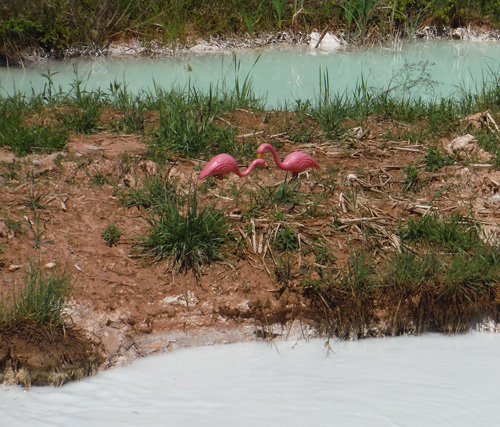
A couple of pink flamingos stand watch over some holding ponds.
After the sediment settles out, the water is pumped back to be reused.
Photo by Lori Carter

Happy GMS members on a fantastic field trip!
Photo by Lori Carter

One last look at the plant before we hit the scrap piles!
Photos by Lori Carter


Some of the goodies from the scrap pile
Photos by Lori Carter
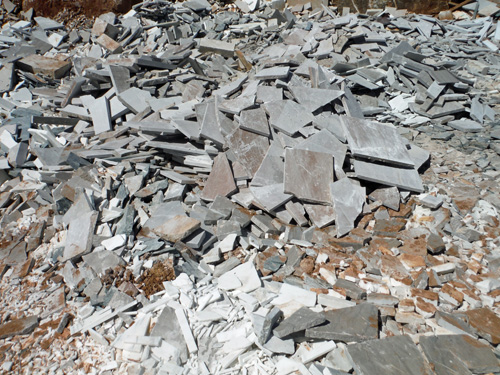

Plenty to pick through
Click below for field trip policies

Copyright © Georgia Mineral Society, Inc.
